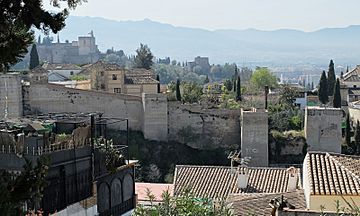Zawi ibn Ziri facts for kids
Quick facts for kids Zawi ibn Ziri |
|||||
|---|---|---|---|---|---|
| Emir | |||||
| Zirid King of Granada | |||||
| Reign | 1013 – 1019/1020 | ||||
| Successor | Habbus al-Muzaffar | ||||
| Born | c. 955 Achir |
||||
| Died | 1034 or 1035 Algiers |
||||
|
|||||
| Arabic | المنصور زاوي بن زيري بن مناد الصنهاجي | ||||
| Dynasty | Zirids | ||||
| Father | Ziri ibn Manad | ||||
Zawi ibn Ziri as-Sanhaji was an important leader of the Berber Sanhaja tribe. He arrived in Spain in the year 1000. At that time, Spain was ruled by a powerful Islamic empire called the Caliphate of Córdoba. Zawi helped lead a rebellion against this empire. He and his followers settled in an area called Elvira. He then founded a new kingdom known as the Taifa of Granada. Zawi became its first ruler, called an Emir, leading the Zirid dynasty from 1013 to 1019.
Contents
The Zirid Family: A Powerful Dynasty
The Zirid family was very important in North Africa and Spain. Let's learn more about Zawi's family and how they became powerful.
Zawi's Father: Ziri ibn Manad
Zawi's father, Ziri ibn Manad, was the first leader of the Berber Sanhaja tribe. He was loyal to the Fatimid Caliphate, another large Islamic empire. In 944, Ziri was allowed to start the Zirid dynasty in a region called the Maghreb (North Africa). He also built the city of El Achir.
In 970, Ziri fought against another tribe called the Zenata. During a fierce battle, Ziri's horse fell, and he was left alone. The Zenata tribe captured him and cut off his head. His head was later displayed in a market in Cordoba, Spain.
Zawi's Brother and Nephews
After Ziri's death, his son Buluggin ibn Ziri became the governor of the Maghreb. The Fatimids had moved their capital to Cairo, so the Sanhaja tribe was left to defend against attacks from Spanish rulers and their allies. The Sanhaja successfully defeated an invasion in 973.
When Buluggin died in 984, his lands were divided. His son, al-Mansur ibn Buluggin, continued the Zirid dynasty. Another son, Hammad ibn Buluggin, took control of lands further west.
During the rule of Zawi's nephew, al-Mansur (983-995), the Zirid family faced problems. There were disagreements within the family, and they started to become less connected to their Fatimid rulers.
Zawi Leaves for Spain
Badis ibn Mansur, al-Mansur's son, became the next Zirid ruler. After trying and failing to attack Badis in 999 and 1000, Zawi decided to leave North Africa. He moved to Spain with his son, nephews, and many followers.
Zawi's Time in Al-Andalus (Spain)
When Zawi arrived in Spain, a powerful leader named Almanzor was in charge of the Caliphate of Córdoba. Almanzor welcomed Zawi and his followers. He wanted the Berbers to help him gain more power and reduce the authority of the Caliph, Hisham II. Almanzor used Berber soldiers, including the Sanhaja and Zenata tribes, to replace other troops.
The Sanhaja tribe became very strong and supported Almanzor and his sons. Zawi played a big part in the war between the Spanish Muslims and the Berber soldiers. With the help of other Berber tribes, Zawi attacked Cordoba. They wanted to make Sulayman ibn al-Hakam their new caliph.
The Berbers entered Cordoba and caused a lot of trouble. They took people's belongings and harmed many families. During this time, Zawi found his father's head, which had been displayed on the citadel. He took it to bury it properly with his father's body.
After Cordoba fell, the Berber leaders started to argue among themselves. This caused problems all over the country. Berber leaders and powerful officials took control of cities and regions. The Sanhaja, who already controlled the Elvira countryside, then took over the city itself.
Founding Granada

Soon after settling in the area, Zawi moved his capital. He chose a more easily defended location nearby, which was then a small settlement called Gharnāṭa. This is where Zawi founded what we know today as the city of Granada. It became the capital of his new kingdom, the Taifa of Granada.
In April 1018, an army led by Ibn Hazm tried to capture Granada from the Zirids, but they were badly defeated. Zawi was very upset by the violence and bad actions of his own people during the civil war. He believed these actions would lead to the downfall of his new kingdom. So, Zawi decided to leave Spain. He returned to the Maghreb in 1020. Before leaving, he appointed his nephew, Habbus al-Muzaffar, to rule in his place.
Return to the Maghreb
When Zawi returned to North Africa, he was welcomed with honor by his great-grandnephew, Al-Mu'izz ibn Badis, who was the Zirid ruler there. Zawi then buried his father's head in the tomb with his father's body, finally bringing him peace.
What Happened Next in Granada
After Zawi left, Habbus al-Muzaffar took charge of the Taifa of Granada. He continued to build and develop the city. The Zirid dynasty ruled Granada until 1238. After that, Muhammad I of Granada founded the Nasrid dynasty. The Nasrids built the famous Alhambra palace. They ruled Granada until January 2, 1492, when the armies of the Catholic Monarchs conquered the city. This was the end of Muslim rule in Spain.
See also
 In Spanish: Zawi ben Ziri para niños
In Spanish: Zawi ben Ziri para niños


